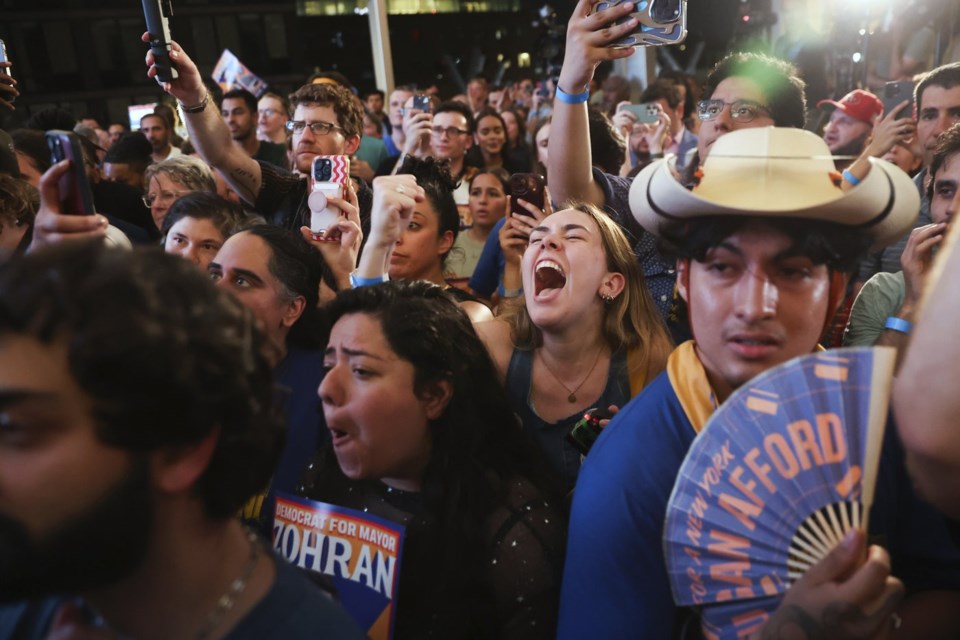NEW YORK (AP) ‚ÄĒ On Tuesday night, shortly before polls closed in New York's Democratic mayoral primary, and less than an hour until the first signs of his seismic upset over Andrew Cuomo, was in a Brooklyn park, searching for a ride.
‚ÄúHe said he‚Äôd met some kids in the park who still hadn‚Äôt voted, so he sent his personal driver to get them to a poll site before it closed,‚ÄĚ recalled Charlie Dulik, a campaign volunteer and tenant organizer, who said he approached Mamdani in the park to say hello.
Instead, Mamdani climbed into Dulik‚Äôs 2007 Toyota Highlander, drawing cheers from passing pedestrians and cyclists as he made his last-minute pitch to voters while hanging from the car‚Äôs sunroof, according to the volunteer. ‚ÄúHe just kept saying, ‚ÄėIt‚Äôs razor thin,‚Äô‚ÄĚ Dulik added.
While the results are not yet finalized, Mamdani’s likely primary victory has , leaving many astonished that a 33-year-old democratic socialist outmaneuvered the better-funded and more experienced Cuomo.
Those close to the Mamdani campaign are less surprised. They credit a seemingly omnipresent candidate devoted to speaking directly to New Yorkers, along with a sprawling field operation that helped amplify his affordability-centered platform to new voters.
As Mamdani prepares for the November general election, they say they intend to return to that playbook once again.
‚ÄúFrom the very beginning, he was very clear that our ground game was going to be the backbone of this entire campaign,‚ÄĚ said Jason Halal, a lead field canvasser for Mamdani. ‚ÄúThere was never any lack of urgency, and we got that from the top down.‚ÄĚ
A ‚ÄėRose Garden‚Äô front-runner
Mamdani’s approach offered a stark contrast to Cuomo’s campaign. The former governor, who four years ago over a barrage of sexual harassment allegations, rarely put out a public schedule, chafed at questions from reporters and skipped most candidate forums.
He received fewer individual donations than Mamdani, but more than $25 million in super PAC funds, which were poured into ads that framed the city as beset by chaos.
‚ÄúHe was running a Rose Garden strategy that might‚Äôve suited him as governor, but voters expect an intimacy from the mayor of New York City,‚ÄĚ said Basil Smikle, a Democratic political strategist and professor at Columbia University. ‚ÄúThey want to see you at the subway stop, the local pizza shop, at church.‚ÄĚ
Even Cuomo‚Äôs backers ‚ÄĒ including several prominent labor unions ‚ÄĒ ‚Äúdidn‚Äôt seem that enthusiastic about him,‚ÄĚ Smikle said, noting that with Mamdani‚Äôs campaign, ‚Äúyou saw both that anger toward the current party and hopefulness in the street.‚ÄĚ
A Cuomo spokesperson did not respond to inquiries about the campaign’s field operations, including how many volunteers had signed up.
But some voters took notice of the candidate’s absence.
As she went to vote Tuesday, Michelle Hemmings Harrington, 70, a one-time supporter of the former governor, said she felt as though Cuomo was ‚Äútaking our votes for granted.‚ÄĚ
She carried a pile of Mamdani pamphlets and a water bottle, both handed to her by the group of nearly a dozen of his campaign volunteers stationed around her Brooklyn polling site.
One million doors
When Mamdani launched his campaign late last year, few New Yorkers had heard of the two-term assemblyman. His solution: recruit an army of volunteers to knock on 1 million doors.
Much of that effort was coordinated by the Democratic Socialists of America, a left-wing organization that counts Mamdani as a member, with experience canvassing for Rep. Alexandria Ocasio-Cortez and other progressives.
Volunteers used an app to track the outcome of each door knock. Another app allowed them to text everyone in their phone contacts and ensure they had a plan to vote ‚ÄĒ a strategy known as ‚Äúrelational organizing.‚ÄĚ
Armed with brightly colored campaign literature and screen-printed merch, supporters also set up shop around concert venues and downtown bars. They hosted cheeky events that dovetailed with Mamdani’s youth-friendly social strategy, including a and a canvas launch.
Volunteers received a ‚ÄúZetroCard,‚ÄĚ a play on the city‚Äôs MetroCard, to keep track of how many times they canvassed.
"It felt joyous and optimistic at a time when people are feeling really scared and disillusioned by the state of the world," said Halal, the field organizer.
‚ÄėThey wanted to be part of this‚Äô
As Mamdani’s exposure increased in recent weeks, the number of volunteers ballooned. They came from as far as Ireland and Hawaii, though many were young New Yorkers not previously involved in politics, according to Alvaro Lopez, the electoral coordinator for the city’s DSA chapter.
‚ÄúPeople would come to us who never even thought of canvassing and say they wanted to get involved, they wanted to get to know their neighbors, they wanted to be part of this,‚ÄĚ Lopez said. ‚ÄúWe went from basically 300 volunteers in December to being able to launch canvases throughout the city with over 10,000 people.‚ÄĚ
Early in the campaign, Lopez said he’d met with a 100-year-old woman in the neighborhood of East Williamsburg, where he grew up. The woman, a former city employee, hadn’t heard of Mamdani when Lopez showed up. By the end of their conversation, she said she wanted to contribute to his campaign in any way she could.
‚ÄúCanvassing is about bringing ideas to people that can make them feel like they‚Äôre part of a broader political project,‚ÄĚ Lopez said. ‚ÄúOur message made sense to her: she felt like it was time for a change.‚ÄĚ
Jake Offenhartz, The Associated Press



